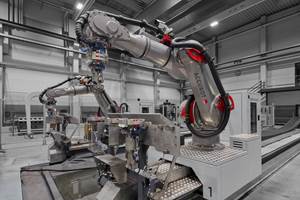Reading the Boeing tea leaves
Boeing CEO David Calhoun says not to expect a new aircraft before 2035. What are aerocomposites fabricators supposed to make of that?
Photo Credit: Getty Images
Boeing CEO David Calhoun announced at the company’s in early November that Boeing has no plans to announce a new aircraft program until almost 2030 and that the market should not expect a new aircraft from the company to enter into service (EIS) until 2035 at the soonest.
“I don’t want to fill a gap in a product line,” Calhoun said. “I want to build a product that’s going to differentiate in a way that absolutely substitutes the airplanes that came before it. That number has to be at least 20%, 25%, maybe 30% better than airplanes it replaces. And there are technologies and concepts that go with that, and underlying ways of building it that can get you to that answer, and they all take time, and they all have to be proven.”
He added, later: “...If it [a new aircraft] doesn’t have a sustainability wrapper all around it, if it can’t meet the emissions tests, if it can’t deliver significant performance advantages, then there won't be an airplane. It just won’t [happen]. We may not even be allowed to introduce an airplane that doesn’t do something like that.”
To provide some context: Boeing has spent much of the last three years very focused on righting the ship following two 737 MAX crashes, COVID-19 and a delay in 787 deliveries caused by anomalies in some composite fuselage sections. The 737 MAX is flying again, 787s are being delivered and air travel has steadily increased post-COVID, but Boeing is in a competitive struggle with Airbus.
The European planemaker maintains a comprehensive product portfolio, and the company’s long-range narrowbody A321XLR, introduced in 2019, is in great demand among customers, having racked up more than 500 orders. Boeing, by contrast, lacks a model to compete with the A321XLR, and is feeling pressure from customers to develop one.
Boeing needs a healthy supply chain as much as the supply chain needs Boeing.
So, a common question asked of Calhoun at any investor event is if and when Boeing will announce a new aircraft to compete with the A321XLR. Calhoun’s statement in November is the clearest he’s made on this topic.
Many aerospace industry observers and analysts have spent the last year trying to determine what Boeing’s timeline might be, operating under the assumption that Boeing appreciates the precarious competitive position it’s in and would move sooner than later to remedy that. Airbus certainly has a head start with the A321XLR, but if Boeing announced a new long-range narrowbody in 2024, it could have an EIS of 2032.
Calhoun’s rationale for not moving sooner on a new program boils down to his desire that Boeing’s next new aircraft be a differentiator — substantially more fuel efficient, wieth fewer emissions and a smaller carbon footprint. Anything less, apparently, is a non-starter. These certainly are admirable goals, but refusing in 2022 to even consider a new aircraft coming to market for another 13 years sends some bad signals.
The first bad signal is being sent to customers. They almost certainly want a more efficient and cleaner aircraft as much as Calhoun does, but they also want the option to buy a long-range narrowbody from a company other than Airbus. Further, airlines benefit from and prefer a competitive marketplace when making buying decisions, and Boeing’s abandonment of the middle of the market minimizes their options and leaves Airbus at a distinct advantage when it comes to aircraft pricing.
The second bad signal is being sent to the supply chain. Suppliers in the commercial aerospace industry — including composite material suppliers and composites fabricators — serve their customers most effectively if Boeing and Airbus have vibrant and active programs that drive innovation and help build product and technology diversity. What is an aerocomposites fabricator that has a history in the Boeing supply chain supposed to think of Calhoun’s statement? Boeing needs a healthy supply chain as much as the supply chain needs Boeing. If suppliers see limited benefit in remaining in the Boeing supply chain, they will naturally seek business elsewhere, with Airbus, Northrop Grumman, Lockheed Martin, Spirit AeroSystems and others. And they might not return.
With so much at stake and so much to lose, it is a genuine puzzle why Calhoun has staked this position. My hope is that it’s one Boeing will, eventually, reconsider. And, frankly, Boeing probably must reconsider this position if it wants to maintain its position as one of the preeminent aerospace OEMs.
Related Content
Plant tour: Aernnova Composites, Toledo and Illescas, Spain
RTM and ATL/AFP high-rate production sites feature this composites and engineering leader’s continued push for excellence and innovation for future airframes.
Read MoreFirst Airbus A350 crash confirmed in Haneda
Shortly after touch-down, a JAL A350-900 aircraft recently collided with a De Havilland Canada Dash 8. Exact circumstances are still unknown.
Read MoreAutomated robotic NDT enhances capabilities for composites
Kineco Kaman Composites India uses a bespoke Fill Accubot ultrasonic testing system to boost inspection efficiency and productivity.
Read MorePlant tour: Airbus, Illescas, Spain
Airbus’ Illescas facility, featuring highly automated composites processes for the A350 lower wing cover and one-piece Section 19 fuselage barrels, works toward production ramp-ups and next-generation aircraft.
Read MoreRead Next
Next-gen fan blades: Hybrid twin RTM, printed sensors, laser shock disassembly
MORPHO project demonstrates blade with 20% faster RTM cure cycle, uses AI-based monitoring for improved maintenance/life cycle management and proves laser shock disassembly for recycling.
Read MoreScaling up, optimizing the flax fiber composite camper
Greenlander’s Sherpa RV cab, which is largely constructed from flax fiber/bio-epoxy sandwich panels, nears commercial production readiness and next-generation scale-up.
Read MoreUltrasonic welding for in-space manufacturing of CFRTP
Agile Ultrasonics and NASA trial robotic-compatible carbon fiber-reinforced thermoplastic ultrasonic welding technology for space structures.
Read More












